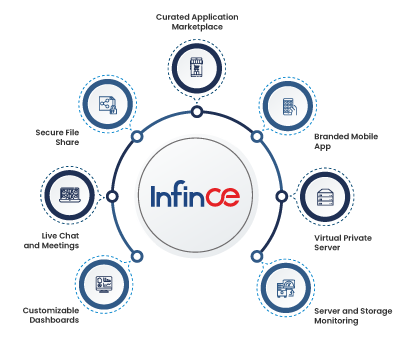The Underlying Benefits of Using a Business Phone System
A business phone system can be defined as “a system where businesses use multiple telephones in an interconnected fashion that allows for features like call handling and transferring, conference calling, call metering and accounting, private and shared voice message boxes, etc.”
Business phones or VoIP phones are a great tool to facilitate your business communication needs. Business phone systems help manage large call volumes. With a business phone in place, you can route all the incoming, outgoing, and internal calls through a unified platform.
Read more: 7 Reasons for a Small Business to Adopt Cloud Business Phone System
Modern business phone systems come with multiple features to simplify communication management for the organization. From call recording, forwarding, and rerouting multiple calls to voicemail, IVR messaging, and automated call functions, you can benefit a lot from a reliable business phone system. Here’s everything you need to know about business telephone systems to help you make an informed decision.
Different Types of Business Phone Systems
A business phone system can make call management incredibly convenient for your employees. At the same time, it helps the caller connect to the relevant department immediately to address their concerns. You can make and receive calls from your PC, laptop, tablet, or smartphone by using the business phone system, using a dedicated phone number for your company. The business phone system is a vital part of customer management today. Here are some of the examples of business phone systems.
1. PBX Phone Systems
PBX or Private Branch Exchange phone systems allow you to make and receive calls over the Public Switched Telephone Network (PSTN) via circuit-switched telephony. In other words, PBX phone systems use physical copper wire networks to transmit voice communication as analog signals. In general, PBX phone systems are classified into two categories: on-premise and cloud-based PBX systems.
On-premise PBX phone systems employ bulky hardware that includes physical wires, PBX servers, and specialized phones. The system uses a trunk line with internal telephones, enabling the user to communicate within the network without using any external lines. This makes on-premise PBX phone systems an excellent choice for external as well as internal communication. However, many businesses choose cloud-based PBX phones instead of on-premise systems due to their infrastructure and maintenance expenses.
Cloud PBX phone systems employ a web-based cloud telephony platform to give you all the features you can expect from an on-premise PBX system. However, they do not require any specialized hardware, as seen in the latter. You can route the calls to your employees’ cell phones or the usual business line to facilitate communication. Apart from that, cloud-based PBX phones also offer additional features like call switching, access control, and better flexibility and visibility into the platform.
Read more: 5 Ways an Integrated Cloud Platform is Beneficial for Your Small Business
2. VoIP Phone Systems
Voice over Internet Protocol (VoIP) phone system enables you to make and receive calls using the IP network. VoIP phones transmit voice communication and other types of multimedia communication over the internet using packet-switched telephony. Thus, it helps avoid the usual problems of a traditional business phone like voice breaking and call drops. A VoIP phone system will also be interfaced with PSTN using specialized adapters to route calls via PSTN if required.
Just like PBX phones, VoIP phone systems are also classified into two types: on-premise and cloud-based VoIP systems.
On-premise VoIP phone systems, also known as IP-PBX phones, are very similar to on-premise PBX phone systems in terms of architecture. The main difference between them is that a VoIP phone system uses a VoIP server to route all the incoming and outgoing communication instead of using a private branch exchange. In addition, it requires VoIP-enabled phones to make and receive calls instead of usual phones.
As all the communication is sent and received over the internet, a VoIP phone system is much more cost-effective than an on-premise PBX phone system. Moreover, you can also use VoIP phones to transmit multimedia communication, which is impossible with PBX phones. Still, as on-premise VoIP systems require investing in infrastructure similar to PBX systems, most businesses prefer cloud-based VoIP phones rather than having an on-premise system.
Cloud VoIP phone systems function just like on-premise VoIP phones but without needing any specialized and bulky hardware. There is no hefty cost of installation involved, as the VoIP provider will be responsible for managing the infrastructure on the cloud. You only need VoIP-enabled devices to make and receive calls. There are also options to pay as per usage when you go for cloud VoIP phone services, which further help keep the expenses in check.
Read more: 8 Ways Cloud Automation Significantly Improves Your Legacy IT Operations
Benefits of InfinCE Business Phone System
With the InfinCE business phone system, you can have a dedicated phone number for your company to protect your privacy and keep work and personal phone numbers separate. When you make a call, the receiver will see the caller ID of your organization instead of a private number, which is a valuable asset to affirm the reputation of your business in the industry. Besides, you can also choose from local phone numbers and toll-free numbers to suit your needs with the InfinCE business phone system.
Read more: Introduction to InfinCE Business Phone System
InfinCE business phone allows you to have a virtual phone number for your company and make and receive calls on the go, from anywhere in the world. As a result, you are not confined to your desk and can access your InfinCE account anytime, anywhere, using your preferred device. In addition, InfinCE allows you to buy additional phone numbers and add unlimited extensions. With plans starting at $1 per phone number or user per month, the InfinCE business phone system also helps you enjoy incredible cost savings.
You get to benefit from many more features when you choose the InfinCE business phone system. You can create as many IVR greeting messages as you want, assign extensions to different departments, get dedicated phone numbers for key personnel, and do a lot more to fit your needs for business communication. With multiple extensions in place, none of your customers will have to wait in a queue to get connected to the relevant department when there are simultaneous calls. That will give you a competitive advantage over others in the industry by boosting customer satisfaction rates.
Set up your business phone system with InfinCE and start enjoying smart call management features. Sign up now!















